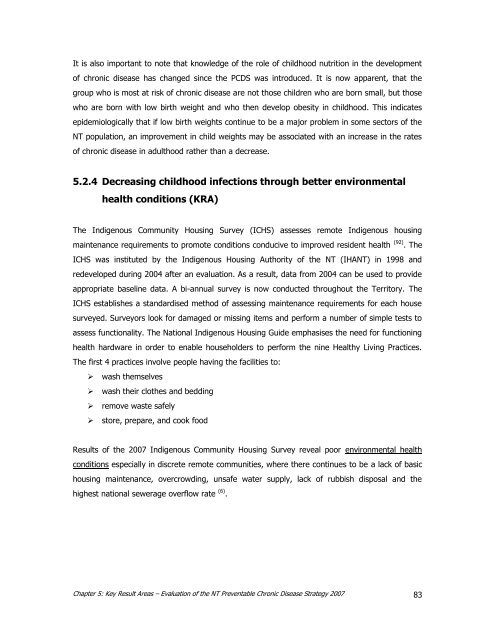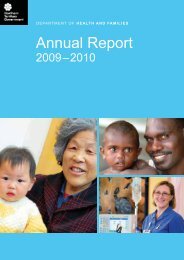PCD Strategy Evaluation 2007.pdf - NT Health Digital Library ...
PCD Strategy Evaluation 2007.pdf - NT Health Digital Library ...
PCD Strategy Evaluation 2007.pdf - NT Health Digital Library ...
You also want an ePaper? Increase the reach of your titles
YUMPU automatically turns print PDFs into web optimized ePapers that Google loves.
It is also important to note that knowledge of the role of childhood nutrition in the developmentof chronic disease has changed since the <strong>PCD</strong>S was introduced. It is now apparent, that thegroup who is most at risk of chronic disease are not those children who are born small, but thosewho are born with low birth weight and who then develop obesity in childhood. This indicatesepidemiologically that if low birth weights continue to be a major problem in some sectors of the<strong>NT</strong> population, an improvement in child weights may be associated with an increase in the ratesof chronic disease in adulthood rather than a decrease.5.2.4 Decreasing childhood infections through better environmentalhealth conditions (KRA)The Indigenous Community Housing Survey (ICHS) assesses remote Indigenous housingmaintenance requirements to promote conditions conducive to improved resident health (92) . TheICHS was instituted by the Indigenous Housing Authority of the <strong>NT</strong> (IHA<strong>NT</strong>) in 1998 andredeveloped during 2004 after an evaluation. As a result, data from 2004 can be used to provideappropriate baseline data. A bi-annual survey is now conducted throughout the Territory. TheICHS establishes a standardised method of assessing maintenance requirements for each housesurveyed. Surveyors look for damaged or missing items and perform a number of simple tests toassess functionality. The National Indigenous Housing Guide emphasises the need for functioninghealth hardware in order to enable householders to perform the nine <strong>Health</strong>y Living Practices.The first 4 practices involve people having the facilities to:‣ wash themselves‣ wash their clothes and bedding‣ remove waste safely‣ store, prepare, and cook foodResults of the 2007 Indigenous Community Housing Survey reveal poor environmental healthconditions especially in discrete remote communities, where there continues to be a lack of basichousing maintenance, overcrowding, unsafe water supply, lack of rubbish disposal and thehighest national sewerage overflow rate (6) .Chapter 5: Key Result Areas – <strong>Evaluation</strong> of the <strong>NT</strong> Preventable Chronic Disease <strong>Strategy</strong> 2007 83
















